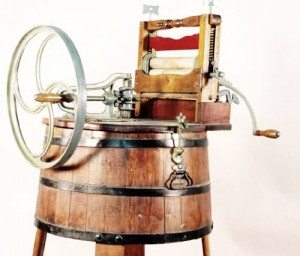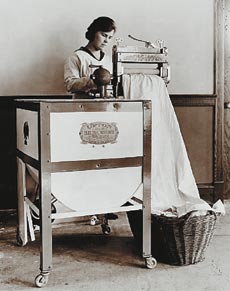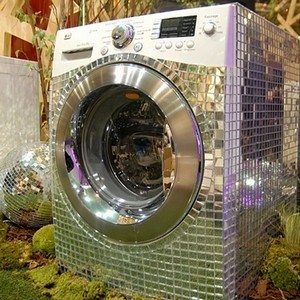The history of the washing machine
 They say that many centuries ago, people who often went to sea on ships came up with an original way of washing. They secured clothes and dirty laundry to a rope with knots and threw them into the water. And the sea waves washed the linen, washing away the dirt from it right as the ship moved. The force of the waves and the speed of the sailing ship created a mechanical effect. It was this that became the first important participant in washing in a modern machine.
They say that many centuries ago, people who often went to sea on ships came up with an original way of washing. They secured clothes and dirty laundry to a rope with knots and threw them into the water. And the sea waves washed the linen, washing away the dirt from it right as the ship moved. The force of the waves and the speed of the sailing ship created a mechanical effect. It was this that became the first important participant in washing in a modern machine.
The second, no less important participant is chemical exposure. People have been using various similar substances for washing and cleaning for quite a long time. Archaeologists have discovered an item used as soap by ancient people in Rome. It was made from fat and ash, which were taken from altars for sacrifices, where animals were sacrificed to the gods.
Dates in the history of the washing machine
 Much later, in those days when the patent office appeared, many inventors began to register inventions that were aimed at facilitating the process of washing clothes.
Much later, in those days when the patent office appeared, many inventors began to register inventions that were aimed at facilitating the process of washing clothes.
- The year 1797 pleased us by giving us a washing board. This household item has taken root in many homes and families for a long time.
- 1851 J. King, an American resident, received a patent for the first washing machine with its own rotating drum. It had a manual drive. And in order to wash in it, you had to rotate the handle. It served as a prototype for the creation of a modern washing machine.
- More than two thousand patents were received by various people who came up with various devices to make washing things easier by 1985.Not every idea of the inventors turned out to be “viable” and developed into something useful in the future.
It is worth noting the original machine, which was invented and brought to life by a Californian gold prospector in 1851. In one wash she was able to wash a dozen or even more shirts. In order for it to function it was necessary to use manpower. This was performed by about a dozen mules. An enterprising inventor began to earn money from his washing machine by washing his colleagues for gold.
It is generally accepted that the first laundry arose due to the need for washing by a large number of bachelors. Who knows, perhaps this happened in one of the gold miners’ settlements.
After washing, it is necessary to wring out the washed items. How can this process be made easier? The year 1861 brought us the first washing rollers. A wet item was placed between them, and by rotating the handle, the rotation of the rollers was created. The item passed through tightly pressed rollers, and the water was wrung out. You can find exactly the same rollers on semi-automatic washing machines, which were recently used for washing.
Until the end of the nineteenth century, the bulk of washing machines worked exclusively with the help of manpower. That is, with the help of various livestock or the strength of people. William Blackstone's invention functioned in the same way. An adult man living in Indiana delighted his wife by giving her a handmade washing machine for her birthday.
This device is considered to be the first example of a household washing machine. It turned out to be the first machine that was put into mass production and widely sold.William showed the qualities of an excellent businessman. He founded the production of his invention, which he sold for two and a half dollars per unit. The company created by this man continues to operate and produce washing machines today.
In Colorado, in a small town called Eaton, there is a washing machine museum. Its founder, Lee Maxwell, collected a large collection of various washing machines made at the beginning of the last century. At the time of writing, the museum houses more than six hundred exhibits. Interestingly, they are all in working order.
Motorized washing machines
 The turning point in washing was the use of a motor. Some engines ran on gasoline. Others are electric. The pioneer (or one of them) in the mass production of washing machines with an electric motor was the Thor machine. It was created in Chicago in 1908. Its creator, American Alva Fisher, became the inventor of a new type of household appliance.
The turning point in washing was the use of a motor. Some engines ran on gasoline. Others are electric. The pioneer (or one of them) in the mass production of washing machines with an electric motor was the Thor machine. It was created in Chicago in 1908. Its creator, American Alva Fisher, became the inventor of a new type of household appliance.
In 1920, there were more than 1,300 organizations producing typewriters in America. Most of them have not survived to this day. However, there are those that still exist today. Then a company appeared Whirlpool Corporation. You can also see products from this company in modern household appliance stores.
Washing machines continued to be improved. And if the first samples had open components and were dangerous for a careless user, then the newer machines were safe and had a pleasant appearance.
The emergence and development of washing machines and other household electrical appliances significantly influenced the lives of Americans. The number of people working as servants has decreased. And the need for laundry services has decreased. By 1953, the number of washing machines sold was approximately 1,400,000 units. And one machine cost about sixty American dollars.
The evolution of washing machines
- 20s of the 20th century - tanks made of wood and copper are replaced by enameled ones.
- 30s of the 20th century - drain pumps powered by electricity began to be used. And also timers.
- 1949 The first software device. And an automatic washing machine appeared.
- 50s of the 20th century - an automatic push-up mode appears.
- 1978 – the machine is made using a microprocessor.
- The beginning of our century - washing machines are integrated into the “smart home” system.
Manufacturers of washing machines continue to improve their “brainchildren”. New washing modes, additional functions and other innovations are being created.
Modern washing machines
In washing machines of our time, discrete logic with strictly limited parameters has been replaced by Fuzzy Logic (fuzzy logic). It uses many parameters that can be set and information that is read by various sensors and transmitted to the control module.
The UseLogic system is used in the most modern machines. It analyzes and influences the washing process, bringing it to the optimal level. During washing, various processes are monitored and adjusted. This makes it possible to improve the quality of washing and keep the laundry in excellent condition.
The Clear Water sensor (translated from English as clean water) monitors the level of water contamination. And if necessary, he adjusts the program by adding another rinse.
Safety of modern household appliances
 Nowadays, one of the most developing trends in the development of various equipment is the safety of its use.
Nowadays, one of the most developing trends in the development of various equipment is the safety of its use.
Many washing machines have operating features that are unknown to most users. For example, the Electrolux company supplies its products with systems that lower the temperature of the drain water. This precaution reduces the temperature effect on sewer pipes. Which in turn prolongs their “life”.
One of the most unpleasant failures of washing machines is a leak in the inlet hose. And it is unpleasant not because a new hose is difficult to change or because it is expensive. On the contrary, replacement is easy and a new hose is quite cheap. The problem is that with such a malfunction, you risk flooding both your apartment and the neighbors below.
To avoid the consequences of this breakdown, many washing machine manufacturers use special systems. For example, Anti-Flood (from English: Against the flood). This system is used by Electrolux. Using it, the pressure of the machine is measured and in cases of leakage, certain measures are taken.
Siemens and Bosch use the Aqua-Stop system, which also serves as protection against leaks. When a leak is detected, it immediately shuts off the water supply.
There are also separate devices that serve the same purposes. One such device is the Water-block safety valve. It is mounted in front of the inlet hose. If a leak occurs, it stops the water supply. When the malfunction is eliminated, the valve is unlocked and ready for operation again.
Vertical and front loading of laundry
Front washing machines are more popular in European countries. And in some parts of Europe, for example, in France, vertical machines are more common.
In front-facing vehicles, loading occurs through a transparent hatch, which is located on the front side. Through it you can monitor the progress of the wash. When positioning the machine, it is necessary to take into account that its door opens forward. To use it comfortably, you need to leave free space in front of the machine hatch. You can use the upper part of the machine as a table (only if there is no vibration during operation). If the model of the machine and its location allows, then you can install a sink above it.
On top-loading machines, laundry is placed into the tub through an opening top lid. Therefore, you do not need to worry about free space in front of the machine. But it will be difficult for you to use it as a table. Since the top cover plays the role of a hatch for loading laundry, it must open freely.
Interesting:
Reader comments
- Share your opinion - leave a comment





















Add a comment